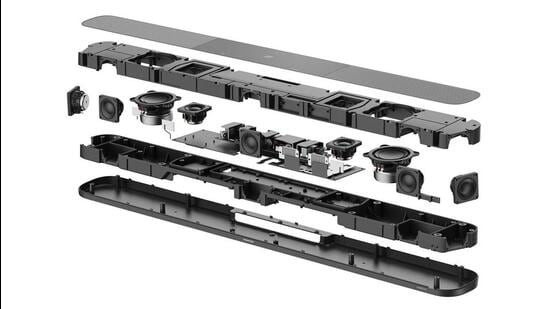A ₹1,39,990 soundbar and ₹69,990 for the accompanying Ambeo Sub sub-woofer isn’t for the fainthearted. It most certainly is a niche. Keeping that as the foundation is important because Sennheiser’s second generation attempts at figuring significantly in your home theatre setup, emerged with a distinct maturity.

Whether this will elicit a reaction from the competition will be a guess. Even if you do not contemplate that far, the Sennheiser Ambeo Soundbar Plus is following a tradition. It now sits alongside the more expensive Sennheiser Ambeo Soundbar Max (that’s around ₹2,24,990). An important element with the design is the height, which has been kept in check well enough for this to not obstruct the view of the TV.
Once the Ambeo Soundbar Plus and the Ambeo Sub are working in sync, the setup that’s essentially created is a 7.1.4 setup – that’s seven audio drivers placed in upward, forward and side firing positioning, each being 2-inch aluminium cones, as well as two 4-inch woofers. Since the basics of directional audio haven’t been forgotten, the soundbar does a good job of blanketing the room with sound, except the illusion you’d expect from physical rear audio speakers, since that’s not physically possible.
But if you are to keep this soundbar in front of the TV (and not inside a bookshelf with a ceiling immediately above, the height of the room’s ceiling will give it a lot more room to work with for audio dispersion without reflections. There seem to be no attempts to alter the sound to give an illusion of rear-audio too.
The feature you need to enable in the companion app, Sennheiser Smart Control, is called Ambeo. Between enabled and disabled, the former certainly adds with to the sound you hear. Works well for movies and TV shows, perhaps not for music or a cricket match.
Connectivity options will be enough for most home theatre configurations – multiple HDMI inputs, optical input, Bluetooth, Apple AirPlay 2 and Google Cast.
But Sennheiser has certainly missed a trick – there are two HDMI inputs (these are passthroughs or for eARC out from the TV), these are limited to HDMI 2.0a. Good enough for 4K content and HDR, but unlike HDMI 2.1 passthrough, cannot handle 4K gaming at 120Hz refresh rate. For the demographic that has a Sony PlayStation 5 or a Microsoft Xbox Series X console, they’ll be better off connecting the console directly to the 4K TV.
Tuning plays a big role in sound, and the versatility of sound. The foundation is set by Sennheiser’s partnership with Fraunhofer-Institute for Integrated Circuits IIS, with wider sound (that’s 3D virtualisation, as they describe it) one of the key focus areas. As you use the Ambeo Soundbar Plus across a variety of content, it is easy to appreciate the richness and clarity, bereft of any audible artificial hues.
There are no on-screen menus emerging from this soundbar, and while there is of course the rather well designed remote too, your best bet would be the Sennheiser Smart Control app (free for iOS and Android). This gives detailed controls for sound, an adaptive sound mode which detects where sound reflections in your room are emerging from, and configuring connected services such as Amazon Alexa and music streaming.
In our case, the System Calibration option that factors in specifics of the room and content source didn’t work. The calibration setup would start, and fail a couple of seconds into the process. Reinstalling the app didn’t sort the matter, a reset of the soundbar did. That’s perplexing, but something Ambeo OS needs improvement with.
Also Read:LG S95QR sets premium audio aspirations amid competition with Bose and Sony
Placing the Ambeo Sub will be important for the best sound. In our experience, keeping it too close to the soundbar leads to a muddled audio heading in your direction. Too far, and the subwoofer becomes too noticeable. Placement will vary depending on your room’s layout and specifics, but it should ideally be placed a couple of feet away.
Sound that emerges from the Ambeo Soundbar Plus is wider, and replicates intricate sound elements, better than you may have initially imagined. Soundbars, often limited by physical size, struggle to replicate audio that’s genuinely wide. The sound of a bullet casing falling on a concrete floor, the rustle of leaves of a rainforest and the shift of a Formula 1 engine from one side to the other make their presence more than adequately felt.
The fact that the sound doesn’t come directly at you, but envelopes you, is testament to how well Sennheiser has tuned the Ambeo Soundbar Plus.
The Ambeo Sub adds to this, but we’d suggest not dialling that up too high – it is quite powerful, and for most of the content you view, level 1 or 2 may be more than enough low frequency addition. While the soundbar also has two woofers, they alone cannot do what a dedicated wireless sub offers with all its might. That’s an observation from testing the Ambeo Soundbar Plus with and without the Ambeo Sub.
There is a genuine softness to how vocals are replicated, even at high volumes. Dialogues are easy on the ears, accentuated by the details emerging from mid-range frequencies.
While Sennheiser have gone a tad lower in the price spectrum and worked with a more compact physical shell for the soundbar, what’s not been lost are the basics of premium sound. There is no sculpting or artificial boosting, and directional audio leads to a sense of wide soundstage, particularly with movies. That’s absolutely worth every penny you spend.
It is still a lot of money to be spending on a soundbar for your home theatre, and while this is a good long-term bet, perhaps not so much for those who have a Sony PlayStation 5 or Microsoft Xbox Series X console in the mix. That’s a big miss, amid the larger scheme of things.
